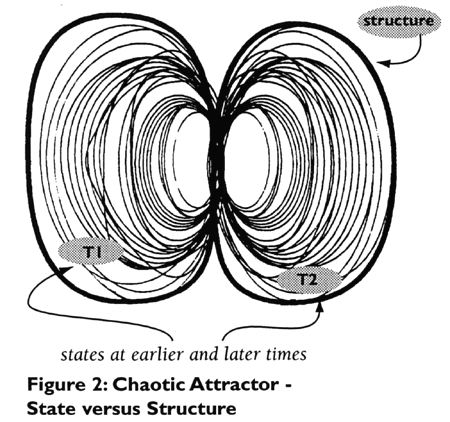
|
||
| Map-makers,
Explorers, and Tricksters: New Roles for Planning and Prediction in Nonlinear, Complex Systems
|
||
|
Attractors:
Nonlinear Geographies with Unpredictable States but Predictable Structures One of the most fascinating findings of complexity theory is that the evolution of nonlinear, complex systems are marked by a series of phases, each of which is under the governance of an attractor(s) dominating the system at that time. These attractors, arising out of the internal nonlinear dynamics plus the influence of environmental factors on the system, act to permit and constrain the range of possible behaviors in the system. Moreover, when attractors change, behavior in the system concomitantly changes as well because it is now operating under the different set of governing rules represented by the newly emergent attractor(s). In fact, it is often possible to determine a great deal about the behavior in a complex systems through an exploration of the qualitative properties of its attractors even when the specific equations modeling the dynamics of the system haven't been solved (Glass & Mackey, 1988). Since an attractor represents the "shape" of a nonlinear system, a "shape" determining its behavior, knowledge of these "shapes" provides some degree of ability to predict the system's behavior. This is the case even for chaotic systems which, as we saw above, are marked by the the presence of sensitive dependence on initial conditions rendering the future states of such systems unpredictable. Chaotic systems have chaotic attractors whose "shape" determines the possible behaviors in the system; see Figure 2.
|
|
|
For example, consider the weather: particular states of the weather would be the temperature or humidity at any particular time ("Today, October 29 is sunny, 54 degrees, with a humidity of 53% with a Southwest wind at 10 mph"). But then there is the climate (Mid-Atlantic, Autumn) which acts as a structure within which particular states of the weather are constrained. In a Mid-Atlantic region during late October, one can predict with a fair amount of certainty that the day-time temperature will be between 45 and 62. (Of course this all becomes more complicated due to the fact that climates change as well Ñ but because climates don't change as fast as the state of the weather, they remain good candidates for predicting the range within which future weather states will occur.) In other words, the climate as structure acts as an attractor for the states of the weather. The nonlinear dynamical psychologist Fred Abraham (1991) has termed this structural predictability of complex systems "insensitivity to initial conditions" to contrast it with the sensitive dependence on initial conditions causing future states to be so unpredictability. Because chaos is aperiodic, each
new state of the system will be novel, not an exact repeat of a previous state. Indeed,
deprivation in prediction turns out to be one of the preconditions of novelty in complex
systems. Yet, even though novelty and uncertainty are being generated in complex,
nonlinear systems, simultaneously, order and redundancy are also being maintained because
of the bounded and patterned arena of the chaotic attractor acting as a structure ordering
the apparently random. |
|
|
This understanding of attractor as predictable structure can be related to what the complexity influenced planning theorist Mike McMaster (1996) has said about foresight into the structure of the future because the future is currently manifested in the structure of the present. Instead of emphasizing prediction per se, McMaster argues for foresight based on an understanding of the unfolding patterns in an organization. Again, this is similar to the earlier point about how comparing present with past assessments can aid leaders in discovering more and more about an organization's identity and using these discoveries to facilitate a greater unfolding of this identity. Planners can enable greater insight into an organization's "identity" by exploiting the idea of attractors as predictable structures. Also relevant here is Gareth Morgan's (1997) point about areas of paradox in an organization being precisely the points where insights into a system's behavior may be accessible. Structure has paradoxical regions (e.g., how chaotic attractors show tendencies toward both divergence and convergence, i.e., the so-called "stretching and folding" of chaos.) Moreover, related to a point made above, if structural predictability can be used to characterize chaotic systems with their extreme form of nonlinear amplified unpredictability, then, structural predictability is even more employable when it comes to systems characterized by a lesser degree of nonlinearity.
|
|
|
Next | Previous Copyright © 2001, Plexus Institute Permission |
